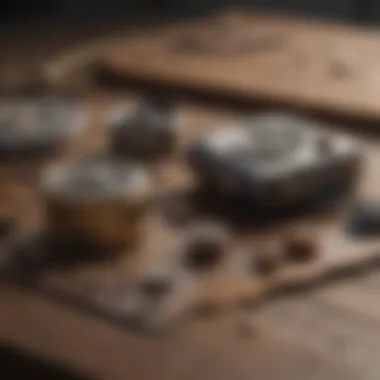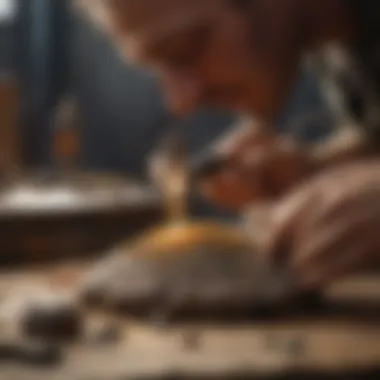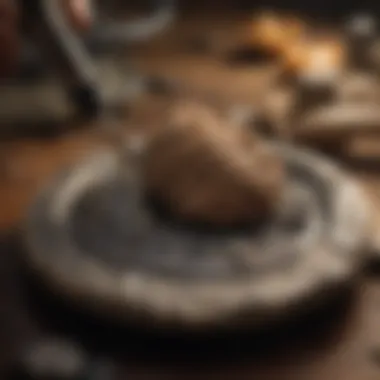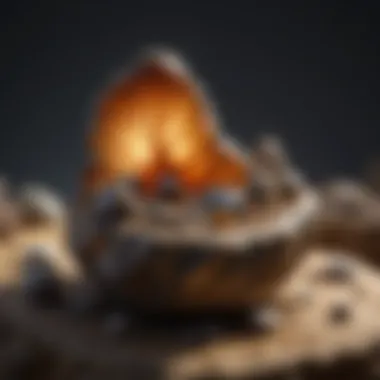Unveiling the Mastery of Dremel Jewelry Polishing for Rock and Fossil Collectors


Rock and Fossil Identification
Rock and fossil identification is a crucial aspect for enthusiasts in the field of collecting geological specimens. Understanding the types of rocks and fossils one may come across is essential to appreciate the geological diversity. Differentiating between sedimentary, metamorphic, and igneous rocks allows collectors to grasp the geological history encapsulated within each specimen. Fossils, ranging from trilobites to ammonites, provide insights into prehistoric life forms and environments. When identifying specimens, specific characteristics such as color, texture, and fossilized remains are key indicators that collectors need to pay close attention to. Utilizing tools like magnifying glasses and mineral hardness kits further aids in accurate identification, ensuring collectors can build a diverse and scientifically valuable collection.
Collecting Tips and Techniques
The journey of collecting rocks and fossils is not merely a hobby; it is a meticulous and rewarding activity that requires careful consideration and technique. Best practices start with researching potential collecting sites, understanding the geological formations in the area, and obtaining any necessary permits. Knowing how to safely extract specimens without causing damage is crucial to preserve the integrity of the specimens. This involves using tools such as rock hammers, chisels, and brushes with precision and care. Collectors should also pack essential supplies such as water, sunscreen, and first aid kits for a safe and enjoyable collecting experience. Locating prime collecting sites involves scouting areas with exposed rock faces, riverbeds, or quarries where rocks and fossils are likely to be accessible. By adhering to these techniques, collectors can enhance their collection while respecting the natural environment.
Preservation and Display
Preserving collected rocks and fossils is fundamental to maintaining their beauty and scientific value over time. Techniques such as cleaning specimens with gentle brushes and distilled water help remove dirt and debris without damaging the delicate surfaces. Proper storage methods include using archival-quality boxes or storage cabinets to protect specimens from moisture, sunlight, and temperature fluctuations. Moreover, labeling each specimen with detailed information on its location, date of collection, and geological context adds value to the collection and facilitates future research. When it comes to display, collectors can showcase their treasures creatively using shadow boxes, mounting stands, or specialized display cases to highlight the unique features of each specimen. By incorporating preservation and display techniques, collectors can ensure their collections endure for generations to come.
Geological Insights
Delving into the world of rocks and fossils offers more than just aesthetic pleasure; it unravels profound insights into Earth's geological history and evolution. Geological formations and processes, such as sedimentation, mountain building, and fossilization, provide a glimpse into the dynamic forces that have shaped the planet over millions of years. Understanding the historical significance of rocks and fossils sheds light on past environments, climate conditions, and evolutionary patterns. Notable discoveries, such as the first dinosaur fossil or a unique geological formation, enrich the scientific narrative and spark curiosity among collectors and researchers alike. By examining geological insights, enthusiasts can appreciate the interconnectedness of Earth's geological past and present, fostering a deep appreciation for the wonders of the natural world.
Introduction to Dremel Jewelry Polishing Kit
The introduction to the Dremel Jewelry Polishing Kit is of paramount significance in this detailed guide crafted specifically for rock and fossil collectors. Aspiring enthusiasts in this field will find the exploration of this kit invaluable for enhancing their skill set and achieving impeccable results in their polishing endeavors. This section sets the tone for the entire article by shedding light on the essential components, techniques, and maintenance tips essential for utilizing the Dremel Jewelry Polishing Kit effectively.
Understanding the Components
Rotary Tool
The Rotary Tool stands as a cornerstone component of the Dremel Jewelry Polishing Kit, playing a pivotal role in the precision polishing process. This versatile tool offers unparalleled control and finesse, allowing users to attain meticulous detailing on various surfaces. The ergonomic design of the Rotary Tool ensures comfortable handling during prolonged polishing sessions. However, due to its high-speed rotation capability, users must exercise caution to prevent mishaps and ensure safety.
Polishing Pads
Polishing Pads are indispensable accessories in the kit, responsible for achieving that exquisite luster on geological specimens. They come in various materials and textures to cater to different polishing requirements. The key advantage of using Polishing Pads is their excellent abrasive quality, enabling users to smoothen rough surfaces with precision. Nevertheless, users need to be cautious to avoid excessive pressure during polishing, which can result in uneven finishes.
Polishing Compound
The Polishing Compound serves as the final touch in the polishing process, enhancing the gloss and shine of the specimens. Its unique chemical composition aids in removing microscratches and imperfections, resulting in a pristine surface. Users appreciate the efficiency of the Polishing Compound in producing professional-grade finishes swiftly. However, overapplication can lead to residue buildup, necessitating meticulous cleaning post-polishing sessions.
Safety Gear
Safety Gear plays a critical role in ensuring the well-being of users during polishing activities. This includes protective eyewear, gloves, and masks to safeguard against potential debris and chemical exposure. The key characteristic of Safety Gear lies in its ability to mitigate risks and promote a safe working environment. While it may seem cumbersome at times, the advantages of protecting oneself from potential hazards far outweigh the minor inconvenience. It is imperative for users to prioritize safety by adhering to safety guidelines and regulations to avoid accidents.
Setting Up the Kit


Secure Work Area
Creating a secure work area is the foundational step in setting up the Dremel Jewelry Polishing Kit. By designating a clutter-free and well-lit workspace, users can focus on their polishing tasks without distractions. The key characteristic of a secure work area is its contribution to promoting efficiency and precision in polishing endeavors. However, users must ensure adequate ventilation to minimize dust inhalation and maintain a healthy working environment.
Attach Polishing Pad
Attaching the Polishing Pad correctly is crucial for seamless polishing operations. Users should align the Pad securely on the Rotary Tool's head to prevent slippage during use. The key advantage of the Polishing Pad lies in its ability to hold the polishing compound evenly for consistent results across the specimen. It is essential to replace worn-out Pads promptly to maintain optimal polishing performance.
Apply Compound
Applying the Polishing Compound evenly on the specimen is a meticulous process that requires attention to detail. Users should distribute the compound in small, controlled amounts to prevent excess buildup and ensure uniform coverage. The unique feature of the Compound is its ability to enhance the specimen's shine and clarity, elevating the overall aesthetic appeal. However, users must exercise restraint in applying the compound to avoid structural damage to delicate specimens.
Choosing the Right Accessories
Different Polishing Bits
Selecting the appropriate Polishing Bits is crucial for achieving desired textures and finishes on geological specimens. Each type of Bit offers distinct abrasive properties to cater to specific polishing requirements. The key characteristic of Different Polishing Bits is their versatility in handling various materials with precision. Users can experiment with different Bits to create unique designs and patterns, enhancing the visual appeal of their polished specimens.
Adjusting Speed
Fine-tuning the speed of the Rotary Tool is essential for adapting to different polishing tasks and specimen types. Users should start at a lower speed for delicate materials and gradually increase it for more robust specimens. The key advantage of adjusting the speed lies in its ability to control the polishing intensity and achieve desired results efficiently. Users can master the art of speed adjustment through practice and experimentation to hone their polishing skills effectively.
Polishing Techniques for Geological Specimens
Polishing techniques for geological specimens play a crucial role in the meticulous art of rock and fossil collection. Achieving the perfect shine and finish on specimens requires a deep understanding of the tools and methods involved. By mastering the polishing techniques outlined in this article, rock and fossil collectors can enhance the beauty and value of their treasures. The process of polishing geological specimens not only enhances their aesthetic appeal but also allows collectors to observe intricate details that may have been hidden beneath rough surfaces.
Preparation
Cleaning the Specimen
Cleaning the specimen is a fundamental step in the preparation process before polishing. Properly cleaning the specimen removes dirt, debris, and unwanted residues that can affect the polishing outcome. Using specialized cleaning solutions and techniques ensures that the specimen's surface is pristine, ready to receive the polishing treatment. Cleaning the specimen also aids in revealing hidden details and textures, providing a clear canvas for the polishing process.
Securing in Place
Securing the specimen in place is essential to ensure stability and safety during the polishing process. Whether using clamps, adhesives, or other securing mechanisms, this step prevents slippage or movement that could lead to uneven polishing results or damage to the specimen. The secure placement of the specimen allows for consistent and controlled polishing, enabling collectors to achieve uniformity in the finished product while minimizing the risk of accidents or mishaps.
Polishing Process
Starting the Tool


Initiating the tool marks the beginning of the polishing process, where the rotary tool comes to life with the application of the polishing compound. Understanding how to start the tool correctly is crucial for maintaining precision and control throughout the polishing procedure. By starting the tool effectively, collectors can set the pace and intensity of the polishing, laying the foundation for a successful polishing session.
Even Pressure Application
Applying even pressure is key to achieving consistent results during polishing. Uneven pressure can lead to irregular finishes or excessive material removal, compromising the specimen's integrity. By maintaining a steady and uniform pressure during the polishing process, collectors can ensure that the desired shine and smoothness are evenly distributed across the specimen's surface.
Rotational Movements
Utilizing rotational movements with the rotary tool helps distribute the polishing compound evenly and prevents overworking specific areas. Rotational motions ensure that all parts of the specimen receive equal treatment, resulting in a uniform polish. Carefully controlling the rotational movements allows collectors to refine specific areas and address varying textures effectively, enhancing the overall appearance and value of the geological specimen.
Finishing Touches
Buffing for Shine
Buffing the specimen is the final step to achieve a lustrous finish and enhance the specimen's visual appeal. The buffing process smoothens any remaining imperfections, creating a glossy sheen that highlights the specimen's unique features. By buffing for shine, collectors can elevate the overall presentation of the specimen, making it visually striking and captivating.
Final Inspection
Conducting a meticulous final inspection is crucial to ensure the quality and integrity of the polished specimen. Inspecting the specimen allows collectors to identify any remaining flaws or areas that require additional buffing or refining. A thorough final inspection guarantees that the specimen meets the desired standards of finish and serves as a testament to the collector's dedication to perfection.
Tips for Maintaining the Kit
Maintenance is crucial in upkeeping the longevity and effectiveness of your Dremel Jewelry Polishing Kit. Proper maintenance ensures that your tools function optimally and produce desirable results. By adhering to maintenance practices, you can guarantee consistent quality outcomes in your polishing endeavors. Cleaning and storing your equipment correctly is pivotal in preserving its lifespan and efficiency. Regular maintenance not only extends the life of your tools but also enhances safety during usage, reducing potential hazards and mishaps. It is advisable to familiarize yourself with the recommended maintenance routine provided by the manufacturer to ensure the durability and performance of your kit.
Cleaning and Storage
Removing Residue
When it pertains to removing residue from your kit, precision is key. Proper residue removal guarantees a clean and optimal working surface for your polishing tasks. The Dremel Jewelry Polishing Kit demands meticulous attention to residue removal to prevent any interference with the polishing process. Utilizing specific cleaning solutions designed for the kit components effectively eliminates residue buildup without damaging the equipment. Moreover, incorporating gentle cleaning techniques preserves the integrity of the tools, thus maintaining their functionality and longevity for prolonged use.
Proper Storage
Effective storage practices play a significant role in safeguarding your Dremel Jewelry Polishing Kit. Properly storing your tools minimizes the risk of damage or wear, ensuring they remain in top condition for future use. It is imperative to store your kit in a dry and dust-free environment to prevent corrosion or contamination, which could compromise the performance of the tools. Organizing your accessories and components systematically not only facilitates easy access but also prevents misplacement or loss. Implementing a systematic storage system prolongs the lifespan and maintains the efficiency of your polishing kit.
Maintenance Practices
Checking Tool Functionality
Regularly checking the functionality of your tools is essential for preempting any issues that may arise during your polishing sessions. By monitoring the performance of your Dremel Jewelry Polishing Kit, you can identify any potential faults or malfunctions and address them promptly. Ensuring that all components are in optimal working condition enhances the precision and quality of your polishing tasks. Implementing a thorough checking routine before each use guarantees a seamless polishing experience and reduces the risk of interruptions due to equipment failure.


Replacing Worn Parts
Replacing worn parts is a critical aspect of maintaining the efficiency and efficacy of your Dremel Jewelry Polishing Kit. Over time, components such as polishing pads and bits experience wear and tear, affecting the quality of the polishing results. Timely replacement of worn parts not only sustains the performance of the kit but also contributes to achieving consistent and superior polishing outcomes. Consultation of the manufacturer's guidelines regarding part replacement intervals is recommended to uphold the functionality and longevity of your polishing tools.
Safety Precautions
Wearing Protective Gear
Prioritizing safety by wearing protective gear is fundamental when operating the Dremel Jewelry Polishing Kit. Shielding yourself from potential hazards such as debris or abrasive particles enhances personal safety and minimizes the risk of injuries. The utilization of safety goggles, gloves, and respirators safeguards against accidental harm and exposure to harmful substances, ensuring a secure working environment. Embracing protective gear as a standard practice promotes a culture of safety consciousness and enhances the overall polishing experience.
Operating in Well-Ventilated Area
Operating the Dremel Jewelry Polishing Kit in a well-ventilated area is paramount for ensuring air quality and respiratory health. Adequate ventilation dissipates fumes and particles generated during the polishing process, reducing the risk of inhalation and respiratory discomfort. Working in a properly ventilated space promotes a healthy environment and mitigates the potential health hazards associated with prolonged exposure to polishing compounds or dust particles. Prioritizing ventilation in your workspace contributes to a safe and comfortable polishing environment.
Exploring Advanced Techniques
In the realm of rock and fossil collecting, delving into advanced techniques opens up new horizons of creativity and precision. By honing skills beyond the basics, enthusiasts can elevate their craft to new levels of sophistication and artistry. Exploring these advanced techniques is crucial for enthusiasts looking to push the boundaries of traditional polishing methods and achieve exceptional results that stand out in the world of geological specimen preparation.
Incorporating Different Polishing Compounds
Diamond Polishing Paste
Diamond polishing paste holds a paramount position within the realm of rock and fossil polishing due to its unparalleled abrasiveness and precision. This high-quality compound is prized for its ability to refine surfaces to a mirror-like finish, showcasing the intricate details of geological specimens. Its key characteristic lies in its ability to produce unmatched luster and clarity, making it a go-to choice for those seeking impeccable results. The unique feature of diamond polishing paste is its exceptional hardness, allowing for precise polishing without compromising the specimen's integrity. While its advantages are clear in enhancing the overall beauty of geological samples, some may find its abrasive nature challenging to work with on delicate materials.
Cerium Oxide
On the other hand, cerium oxide offers a different approach to polishing, known for its versatility and gentler touch on sensitive specimens. This compound stands out for its high suspension stability and efficient removal of scratches, making it a popular option in the rock and fossil community. The key characteristic of cerium oxide is its ability to deliver a smooth, polished surface while being gentle on the material being worked on. Its unique feature lies in its minimal abrasive action, making it ideal for softer rocks and fossils. Despite its advantages in providing a pristine finish, some might perceive its gentler nature as less effective on tougher materials.
Experimenting with Textures
Matte Finish
Matte finish technique offers a distinctive texture that adds elegance and depth to geological specimens. This approach highlights a non-reflective, velvety surface that creates a refined aesthetic appeal, making it a popular choice among collectors aiming for a unique look. The key characteristic of matte finish is its ability to subdue reflections and accentuate subtle details, giving specimens a sophisticated allure. Its unique feature lies in its ability to transform the visual impact of rocks and fossils, presenting them in a stylish, understated manner. While its advantages include a distinct appearance and reduced glare, individuals seeking a high-shine effect might perceive matte finish as less dynamic.
High Gloss
Contrasting the matte finish, the high gloss technique imparts a radiant shine that intensifies the beauty of geological specimens. This method emphasizes a smooth, reflective surface that enhances colors and textures, offering a luxurious finish that captivates the eye. The key characteristic of high gloss is its ability to create a polished, mirror-like appearance, elevating specimens to a showroom quality standard. Its unique feature lies in the depth and luminosity it adds to rocks and fossils, accentuating their natural splendor. While advantages include a dazzling finish and sharp clarity, some collectors may find high gloss too flashy for certain types of specimens.
Creating Intricate Designs
Etching Patterns
Etching patterns involve a meticulous process of engraving intricate designs onto the surface of geological specimens, adding a customized touch that enhances their visual appeal. This technique showcases artistic flair and attention to detail, allowing collectors to personalize rocks and fossils with unique patterns and motifs. The key characteristic of etching patterns is their ability to imbue specimens with individuality and character, creating one-of-a-kind pieces that reflect the collector's creativity. The unique feature of etching patterns lies in the endless design possibilities, from floral motifs to geometric shapes, allowing for endless customization. While advantages include personalization and artistic expression, achieving intricate etchings may require patience and a steady hand.
Inlay Techniques
Inlay techniques involve embedding contrasting materials into geological specimens to create striking visual contrasts and texture combinations. This method blends different elements seamlessly, enhancing the overall aesthetic of rocks and fossils with intricate detailing. The key characteristic of inlay techniques is their ability to add depth and complexity to specimens, captivating viewers with multi-dimensional compositions. The unique feature of inlay techniques lies in the creative interplay between materials, ranging from metals to gemstones, to achieve captivating designs. While advantages include a unique artistic statement and tactile interest, mastering inlay techniques demands precision and an eye for harmonizing diverse textures.







